
As with Volume I, Boris Chertok has extensively revised and expanded the material in Volume II from the original Russian text.In this volume, Chertok takes up his life story after his return from Germany to the Soviet Union in 1946. At the time, Stalin had ordered the foundation of the postwar missile program at an old artillery factory northeast of Moscow. Chertok gives an unprecedented view into the early days of the Soviet missile program. During this time, the new rocket institute known as NII-88 mastered V-2 technology and then quickly outgrew German technological influence by developing powerhl new missiles such as the R-2, the R-5M, and eventually the majestic R-7, the world s first intercontinental ballistic missile. With a keen talent for combining technical and human interests, Chertok writes of the origins and creation of the Baykonur Cosmodrome in a remote desert region of Kazakhstan. He devotes a substantial portion of Volume I1 to describing the launch of the first Sputnik satellite and the early lunar and interplanetary probes designed under legendary Chief Designer Sergey Korolev in the late 1950s and early 1960s. He ends with a detailed description of the famous R-16 catastrophe known as the »Nedelin disaster,» which killed scores of engineers during preparations for a missile launch in 1960. Working on this project continues to be an extraordinary honor and pleasure. I owe a debt of gratitude to many for their hard work in bringing these stories to the English-speaking world. As before, I must thank historian Steve Garber, who supervised the entire project at the NASA History Division. He also provided insightful comments at every stage of the editorial process. Similarly, thanks are due to Jesco von Puttkamer for his continuing support in facilitating communications between the two parties in Russia and the United States. Without his enthusiasm, sponsorship, and support, this project would not have been possible



